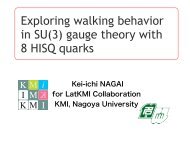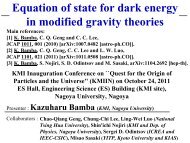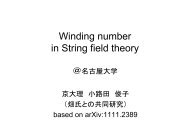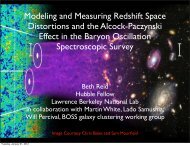Diego Saez-Gomez
Diego Saez-Gomez
Diego Saez-Gomez
Create successful ePaper yourself
Turn your PDF publications into a flip-book with our unique Google optimized e-Paper software.
effective repulsive force 12h<br />
R ∼ reproduced 0<br />
+6h 0 by the F (R) terms . and compare (19) with the binding forces of<br />
for example the Solar ⎪⎩ System). However, to ensure that a little rip is reproduced, one has to stu<br />
acceleration but free of future singularities, which may have a stronger growth in time than thos<br />
big rip singularities. Let us use the reconstruction technique using Eqs. (12-21). As an exam<br />
iods okingof at super-accelerating some of the models expansion reconstructed and it does in not the contain previous any sections, future<br />
(t s<br />
singularity. we can see To for<br />
that find β<br />
the<br />
=1<br />
−t)<br />
out<br />
2 Hubble parameter (25)<br />
a<br />
ay<br />
periodic<br />
lead to<br />
function<br />
a little rip,<br />
that<br />
one<br />
reproduces<br />
has to determine<br />
a cyclic<br />
the<br />
Universe.<br />
duration<br />
From<br />
of each<br />
the<br />
cycle6βh effective<br />
and 0<br />
EoS<br />
the strength<br />
parameter<br />
of the<br />
(t s<br />
for β < 1<br />
−t) (41), it is clear that this<br />
force<br />
odel exhibits<br />
reproduced<br />
periods<br />
by the<br />
of<br />
F<br />
super-accelerating<br />
(R) terms and compare<br />
expansion<br />
with the<br />
and<br />
binding<br />
it does<br />
forces β+1<br />
not contain<br />
of coupled<br />
any<br />
systems<br />
future<br />
(as<br />
singularity. To find out<br />
lar System). However, to ensure that a little rip is reproduced,<br />
the model (25) may lead to a little rip, one hasfunction,<br />
one has to f( study<br />
to determine the duration ˜R) ∝ ˜R models n n = 2 of eternal<br />
(20)<br />
of each cycle and the strength of the<br />
ee of future singularities, which may have a stronger<br />
The<br />
growth<br />
Little<br />
in time<br />
<br />
than<br />
ective repulsive force reproduced by the F (R) terms and compare d<br />
2 those models containing<br />
with the binding forces of coupled systems (as<br />
s. Let us use the reconstruction technique using Eqs. (12-21). −3n As an example, we consider the U(φ) =e −βeαφ ,<br />
r example the Solar System). However, to ensure that a little rip is dt 2 reproduced, +3H d Rip<br />
<br />
R n−1 ∼ (2 − n)R n (21)<br />
dt one has to study models of eternal<br />
celeration but free of future singularities, which may have a stronger n = 2growth free of singularities time than those models containing (22)<br />
g rip singularities. Let us useU(φ) the =e reconstruction technique using Eqs. (12-21). As an example, we consider the<br />
nction, Little Rip in f(R) −βeαφ , (45)<br />
n =<br />
gravity<br />
1 2 + 3µ<br />
(23)<br />
2(1 − 3λ +3µ)<br />
constants. Then, by the expression (21), the Hubble parameter and the scale factor yield,<br />
U(φ) =e −βeαφ , R 2 ˜f(R) (24) (45)<br />
H(t) =h 0 e αt + h 1 , → a(t) =a 0 e 4βeαt +6αt . (46)<br />
here α and<br />
Hubble<br />
β are constants.<br />
parameter<br />
φ = t, H= g (φ) =g (t) (25)<br />
Then, by the expression (21), the Hubble parameter and the scale factor yield,<br />
d h 1 =6α. It is straightforward to see that the function (46) describes aP Universe, (φ) =P 0 (cos where ωφ) 4 for small<br />
(26)<br />
H(t) =h 0 e αt be easily reconstructed by<br />
+ h 1 , → a(t) =a 0 e 4βeαt +6αt the expressions (15) and (20),<br />
ubbleparametercanbeapproximatedasaconstant,reproducingadeSittersolution,asinthe<br />
H(t) =H 0 (cos ω t) 2 +2ω(2 . sin ω t − tan ω t) (27) (46)<br />
del. For large times, the Universe ends in an eternal phantom phase, where the EoS parameter<br />
here ithout h 0 big =4αβ rip singularity. and h 1 =6α. Nevertheless, It is straightforward a little rip to (dissolution see that the of bound function S = structures) dtd (46) 3 x describes g (3) NF( might ˜R) occur a Universe, where(28)<br />
8for small<br />
ilarly es t to α, the Action theHubbleparametercanbeapproximatedasaconstant,reproducingadeSittersolution,asinthe<br />
model presented in Ref. [5], as it is pointed out below. The functions P (φ) and Q(φ)<br />
se structed of ΛCDM by themodel. expressions For large (15) and times, (20), the Universe R = ends 6(2H 2 in+ Ḣ) an and eternal by using phantom expression<br />
8<br />
phase, (13), where which yields,<br />
<br />
Here the couplings κ i are constants depending on C 1,2 .Hence,forsmallvaluesoftheRicciscalartheactionreduces EoS parameter<br />
F (R) <<br />
to−1, the<br />
but<br />
action<br />
without<br />
for General<br />
big rip<br />
Relativity<br />
singularity.<br />
plus power-law H(t) =H<br />
Nevertheless,<br />
curvature 0 [cos(ωt)]<br />
a little<br />
corrections, 2 2ωµ<br />
+<br />
rip (dissolution of bound structures) <br />
might occur<br />
a finite time, P (φ) =e similarly 4βeαφ , toQ(φ) the model =−6αpresented 2 (3 + 4βe αφ in)(3 Ref. + 8βe [5], αφ as )e 4βeαφ it is pointed . out below. F (R) = The<br />
C (47) 1 functions + C 2 4 R <br />
are constants depending on C 1,2 .Hence,forsmallvaluesoftheRicciscalartheactionreduces<br />
1 − 3λ as +3µ R 2 , tan(ωt) 2µ<br />
which is1known −<br />
1 − 3λ recipe +3µ to [sin(ωt)]2 cure the<br />
singularities and which has a viable behavior ([13]). R<br />
12R<br />
+<br />
P + (φ) 75 and e Q(φ)<br />
25<br />
0<br />
ral Relativity plus power-law curvature corrections, as R 2 action (48) represents a viable model where GR can (29)<br />
be recovered while the curvature scalar corrections remain , which small. is It known is important recipe to that cure such theadditional Rcorrections<br />
0<br />
hn be easily reconstructed by the expressions (15) and (20),<br />
hat hasreproduces abecome viablerelevant behavior the solution close ([13]). to(46) the Hence, little can be rip thecalculated evolution. action (48) Inby order represents inverting to estimate athe viable expression themodel time for where ofthe thelittle GR Ricci rip can scalar induced dissolution of<br />
e<br />
nd<br />
curvature<br />
by using<br />
scalar<br />
the expression<br />
corrections<br />
P<br />
(13),<br />
remain<br />
(φ) =e<br />
which<br />
small.<br />
yields,<br />
It is important that such<br />
P (φ)<br />
additional<br />
=P<br />
bound structures in a naive way, one might compare the energy-density 4βeαφ , Q(φ) =−6α 2 (3 + 4βe αφ of a 0 (cos(ωφ))<br />
corrections<br />
− 2(1−3λ)<br />
1−3λ+3µ (30)<br />
<br />
bound<br />
)(3 + 8βe αφ system as the Solar System with<br />
to the the little density rip evolution. ρ )e 4βeαφ F (R) .Forthemodel(46),suchdensitycanbeapproximatedforlargetimesby<br />
In order to estimate time little rip induced dissolution . of<br />
(47)<br />
<br />
S = d<br />
he F (R) action that F (R) reproduces =<br />
C 4 x √ −gβ(φ)L<br />
naive way, one might compare the energy-density<br />
the solution (46) can be calculated by inverting the expression of the Ricci scalar<br />
1 + C 2 4 R of <br />
m (31)<br />
a<br />
exponential<br />
R<br />
bound system as the Solar System with<br />
12R<br />
+<br />
+ 75 e<br />
25<br />
0 16 functions are expanded power series,<br />
themodel(46),suchdensitycanbeapproximatedforlargetimesby<br />
terms adjusted with the dark energy density ρ F (R) = nowadays,<br />
ρ. 0 e 2αt , (48)<br />
(50)<br />
= 6(2H 2 + Ḣ) and by using the expression R<br />
F iner >F 0 (32)<br />
0 (13), which yields,<br />
where ρ R 2 R 3<br />
0 is a constant that<br />
ρ <br />
F (R) =<br />
C 1 + C 2 4 R <br />
1 = −24e −39/12 R 0 ,andC 2 =2 √ can be set F (R) ∼ κ 1 R + κ 2 + κ 3<br />
R 0 R<br />
3R 0 . Hence, we have reconstructed F (R) R model<br />
12R<br />
+<br />
+ 75 e<br />
25<br />
0<br />
which is able to<br />
2 + ··· .<br />
F (R) = ρ 0 e 2αt by imposing that the current value of the energy-density is ρ<br />
, (50) F (R) (t 0 )= 3 κ<br />
H 2 0 2 ∼<br />
10 −47 GeV 4 , where the age of the Universe is takenwhere<br />
to be t 0 ∼ 13.73<br />
ρ F Gyrs, (R) (t 0<br />
accordingtoRef.[14].<br />
)= 3 κ 2 H2 0 ∼ 10 −47 GeV<br />
Onecansetthetime<br />
4 (33)<br />
of the little rip dissolution occurrence when the gravitational coupling of the 0 Sun-Earth 16<br />
accelerated that can be (eternal) set by imposing phase, that whichthe does current not lead valueto ofa the future energy-density . (48)<br />
R<br />
singularity. isNote ρ F (R) that (t 0 )= the 3 system<br />
action (48)<br />
0 κ<br />
H 2 is broken due to the<br />
Einstein-Hilbert action plus some corrections for small<br />
here R 0 = α 2 , C 1 = −24e −39/12 R 0 ,andC 2 =2 √ values of the Ricci curvature R, 2 0 ∼<br />
cosmological expansion. By assuming a mean density of the Sun-Earth system given by ρ ⊙−⊕ =0.594×10<br />
age of the Universe is taken to be t 0 ∼ 13.73 Gyrs, accordingtoRef.[14]. Onecansetthetime where the<br />
−3 kg/m 3 ∼<br />
10 −21 GeV 4 ,thetimeforthelittleripdissolutionofboundstructuresis,<br />
tion ns are occurrence expanded<br />
Time for<br />
when in power<br />
Little<br />
the gravitational series,<br />
Rip<br />
coupling of the<br />
3R<br />
Sun-Earth<br />
0 . Hence,<br />
system<br />
we have<br />
is<br />
reconstructed<br />
broken due to the<br />
F (R) model which is able to<br />
n. By assuming a mean density of the Sun-Earth<br />
produce a super-accelerated (eternal) Rphase, 2 tsystem which R 3 given by ρ<br />
does not lead ⊙−⊕ =0.594×10<br />
to a future singularity. −3 kg/m 3 LR = 13.73 Gyrs + 29.93<br />
∼<br />
Note that the action (48)<br />
forthelittleripdissolutionofboundstructuresis,<br />
α . (51)<br />
rns out to be the Einstein-Hilbert<br />
F (R) ∼ κ 1 R +<br />
action<br />
κ 2 +<br />
R 0<br />
plus<br />
κ 3<br />
Rsome 2 + ···<br />
corrections<br />
.<br />
for small values of the Ricci<br />
(49)<br />
curvature R, where the<br />
Hence, depending on the parameter α, the 0<br />
ponential functions are expanded in power series,<br />
t LR = 13.73 Gyrs + 29.93 appearance of the little rip may last shorter or longer. For example, when<br />
α = 10 −1 Gyrs −1 ,thelittleripoccursattheUniverseageoft<br />
α . LR = 313.03 Gyrs, while for α (51) ≥ 1Gyrs −1 ,thetimefor<br />
the decoupling will be much shorter.<br />
RS. 2 Nojiri, S. ROdintsov AlotofmodelscanbereconstructedinframesofF 3 and DSG, AIP Conf. Proc. 1458, 207 (2011), arXiv:1108.0767.<br />
he parameter α, the appearance of the little F (R) rip∼ may κ 1 R last + κ(R) shorter 2<br />
gravity + κ 3<br />
which + are ··· able . to reproduce a super-accelerating (49)<br />
R<br />
or longer. For example, when<br />
0<br />
where α and β are constants. Then, by the expression (21), the Hubble parameter and the scale<br />
H(t) =h 0 e αt + h 1 , → a(t) =a 0 e 4βeαt +6αt .<br />
where h 0 =4αβ and h 1 =6α. It is straightforward to see that the function (46) describes a Univ<br />
times t α, theHubbleparametercanbeapproximatedasaconstant,reproducingadeSitte<br />
case of ΛCDM model. For large times, the Universe ends in an eternal phantom phase, where<br />
w F (R) < −1, but without big rip singularity. Nevertheless, a little rip (dissolution of bound stru<br />
in a finite time, similarly to the model presented in Ref. [5], as it is pointed out below. The funct<br />
P (φ) =e 4βeαφ , Q(φ) =−6α 2 (3 + 4βe αφ )(3 + 8βe αφ )e 4βeαφ .<br />
The F (R) action that reproduces the solution (46) can be calculated by inverting the expressio<br />
where R 0 = α 2 , C 1 = −24e −39/12 R 0 ,andC 2 =2 √ 3R 0 . Hence, we have reconstructed F (R) mo<br />
reproduce a super-accelerated (eternal) phase, which does not lead to a future singularity. Note<br />
turns out to be the Einstein-Hilbert action plus some corrections for small values of the Ricci cur<br />
One can set the time of the little rip dissolution occurrence when the gravitational coupling of the<br />
Sun-Earth system is broken due to the cosmological expansion by assuming a density for the f(R)<br />
A. López-Revelles,<br />
R0<br />
2 R. Myrzakulov and DSG, Phys. Rev. D 85, 103521 (2012), arXiv:1201.5647.<br />
−1<br />
phase free of singularities. Let us consider, for example, a Hubble parameter that reproduces a phantom Universe<br />
16<br />
.










